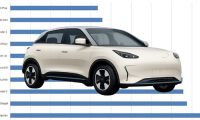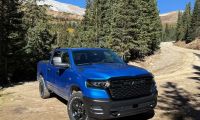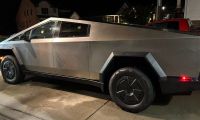Last weekend the NY Times published an article by John Broder about his failed attempt to take a Tesla Model S on a road trip. The article collectively started electric car owners eyes rolling because of the litany of rookie mistakes Broder made. But the story became richer on Monday when Tesla Motors CEO Elon Musk took to twitter and a CNBC interview to slam Broder for publishing a fake story, and promising to write a blog post going over facts and figures. That blog post has not yet been written, but experienced electric car owners such as this writer wish that Broder were just a teensy bit more experienced with electric cars, or had gotten better advice from the Tesla service department.
Elon Musk may have been over the top in his criticism of the Broder's piece, describing the article as "faked" or a "set-up". He must have realized he'd gone too far because within an hour of the first tweet, Musk tweeted that he's not against the NY Times in general, and that their coverage is usually fair. It appears his complaint is with the quality of this specific story.
For a different analysis of this issue see John Goreham's writeup: Tesla's Elon Musk and New York Times in a spat over test
Broder's story covered a road trip he took with a Model S provided by Tesla Motors. He picked it up in Washington D.C. and charged at the Supercharger station in Delaware. He then drove to the Supercharger station in Milford Conn. but along the way noticed the power draw was enough that he wouldn't make it to Milford, and instead he took unnecessarily extreme measures to conserve energy including turning off the climate control and driving at 55 miles/hr in the right-most lane. He barely made it to Milford, and then continued from there to an overnight stay with a friend. Inexplicably he failed to grab a full recharge in Milford. Waking up the next morning the car had lost quite a bit of range, presumably due to the cold weather (10 degrees F). He claims to have been given bad advice from the Tesla service department, drove to a charging station in Norwich 20 miles out of the way, but then he compounded the bad advice by not snagging enough of a charge to make it to Milford. With insufficient range to make it to Milford, he understandably ended up stranded at the side of the road requiring a tow truck trip to the Supercharger station. That gave him an opportunity to snap a picture of a Model S on a flatbed tow truck.
What did Broder do wrong? Any halfway experienced electric car driver can spot several mistakes that Broder made, and we don't need the blog post promised by Elon Musk to diagnose the missteps along the way. We're relying on a blog post by a fellow, Peter, who has taken long distance trips with his Model S, and wrote an open letter to John Broder pointing out his mistakes. Most of what Peter wrote is conventional wisdom for EV owners, some of it is specific to the Model S.
Broder failed to get a full charge in Delaware. He reported that the car claimed to have a 242 mile range which only occurs when is configured for "Standard" charging mode rather than the "Max Range" charging mode. The former doesn't charge the pack to 100%, a well-known tactic for extending battery pack lifespan, while the latter does charge the pack to 100%. The extra 20 miles of range would have made a big difference in Broder's first leg.
Broder failed to get even a trickle charge during his overnight stay. Experienced EV owners know that it's possible, and necessary, to grab charging whenever possible when on a long trip. The Tesla charging system is quite flexible and the car comes with adapters for pretty much any power outlet you can find. He could have found a 120 volt outlet and had a few miles range added to the car and been able to condition the car to warm it up without consuming power out of the battery pack.
The advice Broder claims to have been given to "condition" the battery pack, sit in the car with it running, was simply wrong and used up power that should have been used to drive down the road. Instead, simply driving the car will warm up the battery pack and after a few miles the apparent range should build back up as the pack warms itself.
Broder failed to get a full charge in Milford as well. He reported the car to claim a 176 mile range when he left Milford, which would be barely sufficient for the round trip to/from his overnight stay. He also failed to account for cold weather effects on the battery pack. On this leg of the journey he failed to give himself enough spare range capacity to successfully make the trip. Getting the Model S fully recharged would have taken all of another 20 minutes on the Supercharger. and added 90 miles of range.
There is a "Range" setting on the climate control that Broder should have used, rather than simply turning off the climate control. Using that system, as well as the seat heaters, would have saved a considerable amount of energy. Further, when Broder realized the remaining range may have been insufficient, he should have pulled off the highway to use a regular J1772 charging station.
Driving to Norwich to grab a charge added 22 unnecessary miles to the distance he had to cover to reach the Milford Supercharger. There are other charging stations available along the route to Milford, and he should have used one of them instead.
The critical failures were not grabbing full recharges at the Supercharger stations, and then not grabbing a trickle charge during his overnight stay. The trip would have been a success had he done either or both.
The bigger question here is whether, as Musk claims, Broder set up this scenario so that he could slam Tesla Motors. Or was Broder simply clueless and incompetent. This would hinge on whether Broder purposely failed to take all the steps just outlined, or whether he unwittingly made all those rookie mistakes. Then there is the question of the advice given by the Tesla service department. It's inconceivable that Tesla would advise him to do some of the things he reported having done. Musk, however, claims Broder blatantly ignored the advice given to him and that "It was like he had no desire for a good outcome."
Source: NYTimes












Comments
National Geographic - Tesla
Permalink
National Geographic - Tesla Model S : youtu.be/1OiG8uB6Cic
If I understand correctly,
Permalink
If I understand correctly, the range displayed by the computer fluctuates and is subject to change, and requires one to have a plan B to compensate for weather, etc… The model S is a great car, and I’m not defending the NY times, but I think they have a valid point, and the reported acted as any consumer would do. Is it fair to expect the same outcome from a car as its gasoline cousin? Maybe not, but until EV can alleviate the range anxiety, they have a long way to go. The technology is new, and quite frankly, we can adopt diesel in the US as they have in Europe to get more bang for our buck.
I agree that diesel is a
Permalink
In reply to If I understand correctly, by John Moore (not verified)
I agree that diesel is a stepping stone to alternative fuel vehicles, but it isn't the answer.
What the NY times reporter proved to everyone is that driving an EV is different to driving a gasoline vehicle. Applying gasoline mentality will land you in trouble.
With a car as capable as the Tesla S, the journey should have been straightforward with some planning. He failed to plan or research the car he took delivery of.
Two Frenchmen circumnavigated the entire globe in a 60 mile range Citroen EV using mostly trickle charging. They never ran totally out of charge, even through remote portions of the globe. The reporters failure to navigate through Connecticut is laughable in comparison.
I wonder, what would any
Permalink
I wonder, what would any normal person's response be to someone who said to them,
"I drove my SUV out into the middle of the desert yesterday with only 2 gallons of gas in it. Would you believe it ran out of gas in the middle of no-where and I had to call the AAA to rescue me! These gas cars are junk!"
Unfortunately, separating stupidity from motor-journalists seems to be difficult. Why on Earth would they decide to stay overnight where they couldn't plug the EV in? That is basic EV driving 101.
{brucedp.150m.com}